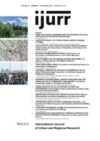For decades community activists fought to increase access to capital for disinvested communities. Now community activists question whether communities have access to capital or capital has access to them. Their concerns are related to the expansion of subprime and predatory lending. The subprime crisis has often been conceptualized as the action of a minor group of predatory lenders, a problem that is individualized, segmented and inherently local. I suggest instead that mortgage capital is the post‐industrial widget, the emblematic product of the post‐industrial economy. Capital accumulated by owners is extracted from urban communities and flows through brokers and lenders to investors and the subprime lending industry, linking global (and local) capital to place. Place is the node that facilitates capital accumulation, completing the flow from the ethereal world of securities and investment in the secondary circuit of capital to the real‐world place of extraction in urban communities. Subprime lending in this context can be seen as a critical component of the financialization of the economy. National housing, macroeconomic and tax policies have expanded the importance of banking and finance within the global and national economy by increasing demand for, and the supply of, mortgage capital. I illustrate the impacts of national financial policy on urban places by examining mortgage foreclosures in Essex County, New Jersey and by talking with residents of one urban community in Newark, New Jersey.
Details
Written by:
KATHE NEWMAN
Digital Object Identifier (DOI)
10.1111/j.1468-2427.2009.00863.x
About DOI
Read full article as PDF
Read full article as HTML
See the references for this article
